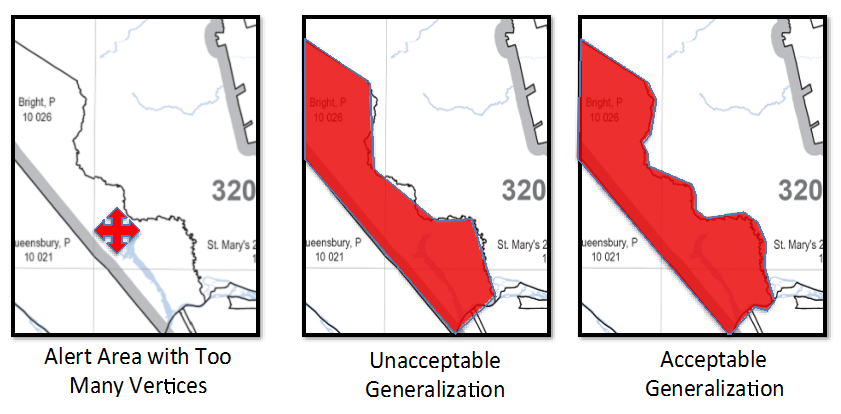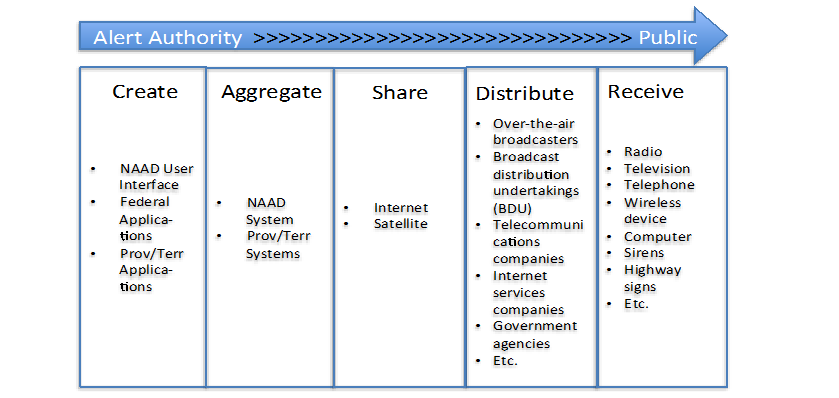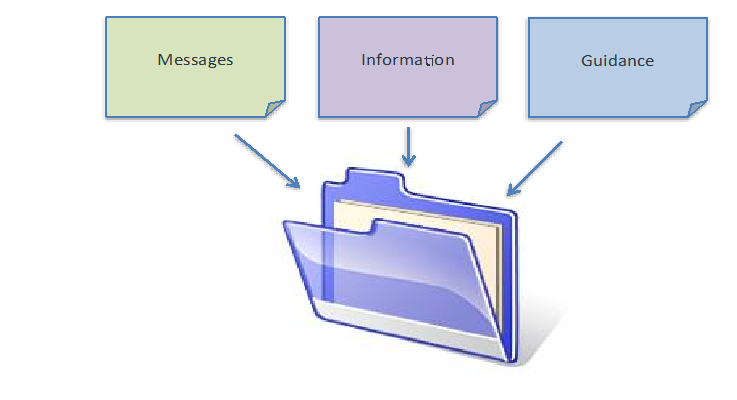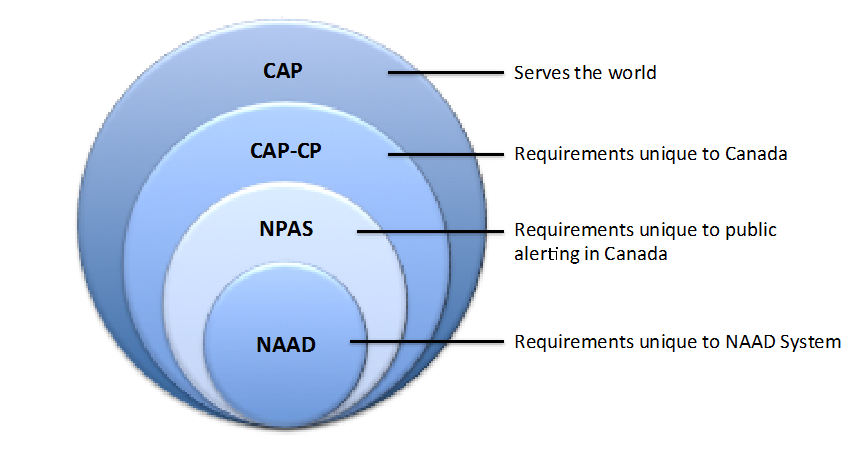ARCHIVE - Common Look and Feel Guidance 1.0
Archived Content
Information identified as archived is provided for reference, research or record-keeping purposes. It is not subject to the Government of Canada Web Standards and has not been altered or updated since it was archived. Please contact us to request a format other than those available.
Table of Contents
- 2 Introduction
- 3 Purpose
- 4 Scope
- 5 Common Look and Feel
- 6 Terminology
- 7 Current State
- 8 Future State
- 9 Credits, Recognition
- APPENDIX A - Constraints
- APPENDIX B - NPAS Concepts
2 Introduction
This document presents the current collection of specifications, policy decisions and recommended practices related to the Common Look and Feel (CLF) of public alerts associated with the National Public Alerting System (NPAS) initiative; for alerting authorities, last mile distributors (LMD), and developers of applications that support the distribution of Canadian public alerts to the CLF objectives. Additionally, this document includes a limited number of forward leaning statements relating to efforts to overcome recognized near term challenges associated with achieving CLF objectives.
This document is versioned and will be updated as lessons are learned and advancements are made. Readers are encouraged to ensure they are working with the most current version of NPAS CLF Guidance by checking at www.CAPAN.ca/NPAS.
This document was produced with the support of the Centre for Security Science (CSS) Canadian Safety and Security Program (CSSP) at the request of the Federal Provincial Territorial (FPT) Senior Officials Responsible for Emergency Management (SOREM) Public Alerting Working Group, and in consultation with the public-private Common Look and Feel Working Group.
3 Purpose
The purpose of this document is to provide Last Mile Distributors (LMD) and alerting authorities with the guidance they require to support the Common Look and Feel (CLF) of public alerts associated with the NPAS initiative.
The forward leaning statements have a purpose of informing system developers and purchasers that may wish to consider future requirements in their current development and purchases, recognizing that doing so may save them costs in the future.
4 Scope
The CLF guidance provided applies to all media unless specifically noted. Guidance for media not yet supported, such as a wireless public alerting system envisioned for Canada, is not included in this version, but can be expected to be included in future versions.
5 Common Look and Feel
Common Look and Feel (CLF) is an objective that aims to make public alerts more readily recognized by the Canadian public.
Ideally, every member of the public an alert is targeted to would receive the same alert content, the same alert signal, the same presentation format, etc., and while that is not achievable through the variety of distribution mediums, there are practices the NPAS community can follow to reduce the differences between broadcasters and distribution mediums.
CLF is not limited to visual and audible presentation. It also relates to alert repetition, expiry practices, the sequence of audience alert messages presented, and other factors.
6 Terminology
- Active Alert:
- An alert message which has not expired or been cancelled.
- Alberta Emergency Alert:
- The province of Alberta's alert aggregation and dissemination system.
- Alerting Authority:
- An authority, recognized by a government authority, having a responsibility for issuing public alerts.
- Alerting Attention Signal:
- An audible signal used to capture attention in advance of the presentation of an audience alert message.
- Alert Message:
- The complete CAP message, which may include multiple audience alert messages. See CAP documentation for further clarification.
- Audience Alert Message:
- A complete message within a CAP message, that may be distinct from another audience alert message because of the language, alert area, severity, etc., and which is identifiable within the CAP message as a separate <info> block. It may or may not include audio and or other resources.
- Broadcasting Distribution Undertaking (BDU):
- An undertaking that distributes the signals of broadcasters.
- Broadcast Delay:
- The time between the CAP alert message being available to a last mile distributor and the audience alert message(s) being presented to the public.
- Broadcast Immediately List:
- A collection of event types and associated CAP urgency, severity and certainty conditions, that have been identified by the Senior Officials Responsible for Emergency Management as having an imminent or unexpected threat to life, that alerting officials wish to be distributed and presented to the public as soon as possible, even if it means disrupting the programming of last mile distributors.
- Broadcast Immediately Alert:
- An audience alert message that aligns with the broadcast immediately list.
- Canadian Profile of the Common Alerting Protocol (CAP-CP):
- A set of rules and references specific to the use of CAP in Canada. www.CAP-CP.ca
- Common Alerting Protocol (CAP):
- The international message protocol adopted for use in NPAS. It is an international standard managed by OASIS, the Organization for the Advancement of Structured Information Standards. http://docs.oasis-open.org/emergency/cap/
- CAP Layer:
- A specification developed by one or more members of the alerting community that relates to the extension of CAP, in accordance with CAP, for including additional content within a CAP alert message. E.g. A “Broadcast Immediately” element value is defined in the SOREM Layer specification.
- CAP Profile:
- A specification developed by one or more members of the alerting community that includes additional constraints and rules for CAP users, all of which must be within the bounds of the CAP standard. e.g. Canadian Profile of the Common Alerting Protocol (CAP-CP).
- Common Look and Feel (CLF):
- The objective of presenting clearly recognizable authoritative audience alert messages to the Canadian public through the diversity of communications media and distributors supporting the NPAS initiative.
- Last Mile Distributor (LMD):
- A party that presents audience alert messages to the public through one or more media. e.g. Radio, television, search engine provider, SMS text message service, etc.
- Layer:
- See CAP Layer.
- National Alert Aggregation & Dissemination (NAAD) System:
- The CAP alert message aggregation system recognized as the national aggregator for NPAS. Owned and operated by Pelmorex Communications Inc. See http://alerts.pelmorex.com/en/
- National Public Alerting System (NPAS):
- The Canadian federal/provincial/territorial government led public alerting initiative.
- Over-the-Air (OTA):
- Refers to radio and television broadcast directly to the end user, and not through a BDU.
- Profile:
- See CAP Profile.
- SOREM:
- Senior Officials Responsible for Emergency Management (SOREM) is a forum of Federal/Provincial/Territorial (F/P/T) officials responsible for coordinating a strategy for emergency management in Canada, and for providing guidance and advice on how to enhance emergency management in Canada. SOREM includes representatives from provincial and territorial emergency management organizations and Public Safety Canada.
- SOREM Layer:
- A public alerting specification developed and owned by SOREM that is currently limited to identifying an audience alert message as “Broadcast Immediately”.
7 Current State
7.1 Specifications
NPAS participants must work within the requirements of the following specifications. LMDs are not expected to process and distribute alert files which are not in compliance with these specifications.
Common Alerting Protocol (CAP)
The Common Alerting Protocol (CAP) is the message protocol adopted for use in NPAS. It is an international standard managed by OASIS, the Organization for the Advancement of Structured Information Standards. CAP is an international standard that can be found in use in many countries of the world.
Current and past versions of the CAP can be found at http://docs.oasis-open.org/emergency/cap/.
Canadian Profile of the Common Alerting Protocol (CAP-CP)
The Canadian Profile of the Common Alerting Protocol (CAP) was developed to address alerting issues specific to Canada. As an example, CAP-CP requires the inclusion of a Canadian <eventCode>, whereas CAP does not.
Current and past versions of the CAP-CP can be found at www.cap-cp.ca.
SOREM Layer (Broadcast Immediately)
The SOREM Layer specifies how a CAP-CP audience alert message may be identified as “Broadcast Immediately”. Its presence in a CAP-CP alert message provides LMD's with a simple indication of whether or not a specific audience alert message is associated with an immediate and life threatening situation that warrants an immediate interruption of television, radio and perhaps other programming. The element may reduce the number of programming variables some LMDs may need to work with while also eliminating future programming changes should the list of CAP-CP events and associated element values on the Broadcast Immediately list change in the future. LMD's may only wish to distribute alerts with the SOREM Layer - Broadcast Immediately flag set to “Yes”.
The SOREM Layer may serve other purposes in the future.
The current version of the specification can be found at http://alerts.pelmorex.com/en/index.php?page=techinfo
7.2 Other Documents
NPAS participants that connect with the National Alert Aggregation and Dissemination (NAAD) System should refer to the most current version of the document titled, National Alert Aggregation and Dissemination System Last Mile Distributor - User Guide, which can be found at http://alerts.pelmorex.com/en/index.php?page=techinfo. An email distribution for updates and notices of this document can be subscribed to.
A document titled Province or Territorial Wide NAAD System Live-to-Air Test Message Policy is forthcoming.
7.3 Guidance
The guidance below applies to all alert messages distributed within the NPAS initiative, and not just those that are “broadcast immediately”. Where guidance is specific to broadcast immediately or a medium, it is noted. To the extent possible, guidance is not repeated. E.g. Official language considerations are not repeated for television; only exceptions are noted.
CAP Message Elements
- LMDs should use the text found in the CAP <description> field in their presentations of the alert to the public, unless they can use a CAP <parameter> better suited for presentation. e.g. Alerts issued from Alberta Emergency Alert provide media specific messages as defined in the Alberta Emergency Alert Layer.
Official Language Considerations
- Alerting authorities are to issue alert messages in at least one of Canada's two official languages, English and/or French, in accordance with their government's legislation.
- Whenever possible and practical, alerting authorities should include audience alert messages in both official languages, in both text and audio versions.
- English and French audience alert messages for the same alert message are to be packaged within separate English and French <info> blocks of a CAP alert message.
- Preferably, the English and French text and audio audience alert messages from alerting authorities will be similarly complete. i.e. Both will include the same event reference, location references, instructions, etc. It is understood this may not be possible and practical for all alerting authorities.
- LMDs are not expected to translate audience alert messages.
- When a CAP alert message includes two or more languages, the LMD should present the alert message in the language(s) best suited to the community they serve in accordance with any applicable regulatory or legislative requirements. e.g. Bilingual community.
- When presenting alert audience messages in more than one language, the first language transmitted should be the principal language broadcast of the medium.
- If an audience alert message is present for only one of the two official languages, it should be used.
Alert Text, Audio, Video
- It is understood that length and or duration of message may be truncated by LMDs to the technical constraints of LMD media. Alerting authorities are therefore encouraged to place the most important information at the beginning of the message to ensure that the most critical information is presented should their text, audio or video exceed the presentation constraints of an LMD.
- See Appendix #1 for recognized medium constraints.
- See Future State #9 regarding how truncation may be avoided in the future.
- It is understood that some LMD applications may be programmed to interpret space, carriage return, new line, etc. in the CAP free form text elements as a single space. Recognizing the number of media that a single audience alert message may be distributed through, all alert originating parties, including reoriginators, should note that trying to influence the presentation in one type of medium, or one LMDs medium, may negatively impact the presentation of the alert audience message in another.
Alerting Attention Signal
- Wherever possible, the Canadian Alerting Attention Signal should be used to introduce audience alert messages that are identified “Broadcast Immediately” and distributed audibly.
- In the event that LMD equipment cannot insert the Canadian Alerting Attention Signal, the use of an alternative alert signal or tone available to the LMD should be used.
- Specifications:
- Composition: The Canadian Alerting Attention Signal is comprised of two alternating complex tones. Tone 1 is formed by the combination of three frequencies, 932.33 Hz, 1046.5 Hz and 3135.96 Hz, modulated at 7271.96 Hz. Tone 2 is formed by the combination of the three frequencies 440Hz, 659.26 Hz and 3135.96 Hz, modulated at 1099.26 Hz.
- The mp3 audio file of the Canadian Alerting Attention Signal can be obtained from participating provincial / territorial emergency management organizations.
- Duration of Signal: 8 seconds.

Image Description
Text
- Relative volume of Canadian Alerting Attention Signal: Should be normalized to stations output.
- Placement: The Canadian Alerting Attention Signal should be placed before the audience alert message audio.
- Repetition: If the audience alert message is repeated, the Signal should precede the repeated audience alert message.
- Interval between the Canadian Alerting Attention Signal and audience alert message: Less than one second.
- The Canadian Alerting Attention Signal is only to be used for the purpose of bringing attention to alerts issued through the NPAS, for testing, and for public education purpose.
- LMD program audio should be off when the Alerting Attention Signal is played.
Repeat Distribution of Audience Alert Messages
- LMDs are expected to distribute or present a Broadcast Immediately audience alert message a minimum of one time.
- LMDs may at their own discretion distribute or present any active audience alert message to the public more than once.
Alert Message Expires, Cancellation
- Alerting authorities are responsible for ensuring their alert messages are expired or cancelled.
- The effective time of an alert message may be ended by issuing an alert with <msgType> value of “Cancel”, or expired using <msgType> value “Update” with an <expires> value set to the current or near current time, and the appropriate reference to the alert the cancel or update refers to.
- The inclusion of an “AllClear” <responseType> is encouraged.
- Note: CAP allows for alert messages to be cancelled without being expired. This may be done by an alerting authority in the hope that the cancel audience alert message is presented in some mediums. E.g. Website. When cancelling an alert message alert authorities are encouraged to provide an expires time.
Multiple Alert Audience Messages for the same Distribution Channel
- LMDs should present alert audience messages in the order of the <sent> time, except in the presence of an <effective> time or Broadcast Immediately value of Yes. Broadcast immediately alert messages should be presented before those that are not broadcast immediately. The <effective> time takes precedence over <sent>.
Broadcast Immediately and Effective Time
- Alerting authorities should ensure that alert audience messages with a Broadcast Immediately value of Yes have an <effective> time equal to <sent>.
Multiple <info> Blocks
- If more than one <info> block of the same language is included in a CAP alert message, the most critical <info> blocks should be placed in the CAP alert message.
- It is understood that some LMDs may only be able to process the first <info> block of a CAP alert message that satisfies the criteria the LMD is programmed for. e.g. Combination of location, broadcast immediately flag, etc.
- All LMDs should be working towards processing alert messages with multiple <info> blocks of the same language.
Updates
- When an LMD receives an update alert message for an alert message that they intend to present and have not yet presented, the LMD should present the updated alert message only.
Broadcast Immediately and Minor Updates
- If an LMD receives an alert message with an <info> block having a SOREM Layer - Broadcast Immediately element value of “Yes”, that also includes a CAP-CP Minor Change element, the LMD is not expected to interrupt programming for the minor change if the referenced alert was already presented. See also Updates 8.1.10.
Polygons
- Alert authorities should, if possible, use the fewest number of polygons required to describe the area of the alert.
- Alert authorities should, if possible, use polygons which do not exceed 150 vertices.
- Any generalization of polygons associated with CAP-CP location references should include all areas of the single location, and may therefore also include areas outside of it. Further, overage should be kept to a minimum. For clarity, alerting a slightly larger area is preferred to alerting an area less than that which the alert has been issued for.

Image Description
Text
Speed of Delivery
- Once an alert message has been published, every party involved in the distribution of that alert should work towards advancing and presenting the audience alert message to the public with as little delay as possible.
- LMDs should strive to present broadcast immediately audience alert messages within one minute of their availability from the aggregator they are sourcing their alerts from.
- If an LMD with a visual and audible presentation (e.g. television) has the alert file in hand and is delayed by the download of audio for more than one minute, it should precede with the visual presentation, preferably with consideration to the guidance found in the section titled Audio Content Considerations 7.3.14.3. The alert signal should still be played.
- Any audience alert message held in an LMD queue to follow a prior audience alert message should be presented following the presentation of the one before it, without a return to the LMDs program.
Audio Content Considerations
- Alerting authorities should aim for audio content of less than 60 seconds per language.
- Audio content that is to be distributed over TV and radio must not exceed 120 seconds in length.
- Audio content should be made available to LMDs as a monophonic MP3 file, using a coding rate of at least 64 kbit/s data.
- Other audio formats may also be supported, depending on the LMD.
- Audio files size should not exceed system requirements. e.g. NAAD System.
- Alerting authorities should not include the Canadian Alerting Attention Signal in the audio file associated with an audience alert message, as it is to be presented by LMDs before presenting the audio content provided to them.
- In the absence of a suitable audio file, LMDs with audio capabilities are encouraged to read the text found in the CAP <description> element or use LMD text-to-speech. A standard message is a least preferred option, that is recognized to be better than no audible message.
Medium Specific Considerations
Television
- Program interruption may be limited to alert messages that have a SOREM Layer – Broadcast Immediately element value setting of “Yes”.
- Automated broadcast interruption need not be used if a person can present the text of an audience alert message verbally and visually mindful of the other guidance found in this document.
- In the absence of a means to deliver an audible message, the Canadian Alerting Attention Signal should be played just prior to presenting the alert visually.
- Full screen single page
- General
- The audience alert message need only be presented until it is acknowledged, removed or channel changed by the viewer.
- The text should be limited to 120 words, or
- approximately 720 characters, per page.
- Single Page
- The background colour should be solid red.
- The text should be white.
- The font should be arial, or similarly clean font, and of a size consistent with content normally presented for reading.
- The text should be centered.
- The entire text should be visible using televisions formatted to 4:3 aspect ratio.
- A banner should be used that reads “EMERGENCY ALERT“ in English and “ (MESSAGE D'ALERTE ou ALERTE) “ in French.
- If a second language is to follow, an indicator should be presented at the bottom of the page. E.g. “Un message français suivra.”; “An English message follows.”
- The page should be presented or available for no less than 15 seconds and no more than 60 seconds.
- Multiple Page
- See full screen single page.
- An indication of the number of pages that are being used to present text should be presented below the banner at all times. e.g. Page x of y pages.
- Crawler insertion
- The background colour should be solid red.
- The text should be white.
- The font should be arial.
- Over-the-air broadcasters should center the crawler block mid-screen to avoid conflict with BDU crawlers that should be located at the bottom or top of the screen.
- OTA recommended placement is 55% of picture height down from the top, and the bottom of the crawler 70% down from the top.
- The text should crawl from the right to the left.
- The text should crawl at a rate that does not exceed 400 characters per minute.
- The crawl may take longer than two minutes.
- The crawl may continue beyond the duration of the audio message.
- Whitespace in the text should be interpreted as a single space.
- Closed captioning considerations
- Closed captioning of the program should not interfere with the presentation of the crawler.
- Audio considerations
- Broadcast audio should be replaced with the alert audio for the duration of the tone and alert.
- Preferably, the alert audio will replace any described video service that may be running at the same time on SAP (NTSC) or VI (ATSC) channels.

Image Description
Text
Radio
- Program interruption may be limited to alert messages that have a SOREM Layer – Broadcast Immediately element value setting of “Yes”.
- Automated broadcast interruption need not be used if a person can present the text of an audience alert message verbally, mindful of the other guidance found in this document.
Event Location
- If the alerting authority includes the actual location of the subject event in the CAP alert message, they should do so to the specifications defined by the CAPAN CAP Event Location Layer. http://capan.ca/uploads/CAP-CP/CAPAN_CAP_Event_Location_Public_Draft_Rev._A.pdf
- Note: CAP <area> is used for describing the threat area the alert should be delivered to recipients within, and not the location of the subject event. CAP does not currently have a data element specific to the subject event location.
8 Future State
Stakeholders are encouraged to review the Technical Advisory Note (TAN) produced by the Centre for Security Science (CSS) Public Safety and Security Program (CSSP) at the request of the Federal Provincial Territorial (FPT) Senior Officials Responsible for Emergency Management (SOREM) Public Alerting Working Group, and in consultation with the public-private Common Look and Feel Working Group. Doing so may support a more comprehensive understanding of current constraints and opportunities. Please note this technical document contains technical recommendations only, whereas the current document is the official guidance document.
A key recommendation from the TAN involves the expanded use of CAP <parameter>. The CLF technical advisory team proposed the community use the optional CAP <parameter> element to provide LMDs with a selection of messages of different length, and perhaps specific to a medium, that LMDs could use. This could reduce errors related to composing messages from different CAP <elements>, the truncation of message segments, etc. Additionally, the CAP <parameter> could be used to convey guidance of the alerting authority to the LMDs. e.g. Repeat presentation of alert messages.
The document is available at www.CAPAN.ca/technical.
9 Credits, Recognition
- Alberta Emergency Management Agency (AEMA)
- Broadcasters Technical Coordinating Committee (BTCC)
- Canadian Radio-television Telecommunications Commission (CRTC)
- CAP EAS Industry Group (ECIG)
- CAP-CP Working Group
- Centre for Security Science (CSS)
- CLF Technical (Tiger) Team of November-December 2012
- Common Look and Feel Sub-Working Group (CLF SWG)
- Pelmorex Communications Inc.
APPENDIX A - Constraints
Recognized Medium Constraints
- Broadcast insertion device
- 1,800 characters (ECIG)
- 120 seconds audio (ECIG, per FCC Part 11)
- NAAD
- CAP File Size
- 5 MB prior to any conversion
- File attachments, including audio
- 800 Kb
- Short message service
- 140 characters (some 160)
- 140 characters
- Consider room for hashtags of retweeter
- Use of URL shortening services can significantly reduce characters required for long web links
- Wireless Emergency Alerting (Future)
- 90 characters (FEMA)
Industry Guidance
- Television
- Full screen
- 720 characters per full screen of text (BTCC)
- 60 seconds per page (BTCC)
- 1 to 2 screens of text per message (BTCC)
- Crawler
- 400 characters per minute (BTCC)
APPENDIX B - NPAS Concepts
NPAS Communications Model
The NPAS all channel communications model supports alerting authorities publishing a single alerting information file to a central collection point for distribution through a variety of communications mediums to the public. As illustrated below, there are five key functions within NPAS: Create an alert, aggregate all alerts, share through efficient communications channels, distribute to the public through a variety of media, and receiving the alert through a variety of communications tools and applications.
Key NPAS functions

Image Description
Text
Distribution of alert messages is voluntary, and the alert authority has limited influence over the channels the alert message will be distributed through once they are in the public domain.
As with all digital content, alert messages may also be redistributed through multiple communications media by other LMDs and the public. In some cases alerting authorities maintain distribution systems, through which they may distribute the alert messages of other alert authorities.
Alerting authorities should note that all alerts issued in NAAD System and the Alberta Emergency Alert will also be available through the Multi-Agency Situational Awareness Systems – National Information Exchanges (MASAS-X), which serves the Canadian public safety community.
Role of CAP - Message Protocol
The Common Alerting Protocol (CAP), which is an alerting message protocol, plays a key role in the NPAS communications model. CAP defines a single alert message file which includes a collection of one or more audience alert messages (and referenced content) to be presented to the public. Additionally, sufficient information, along with some supplemental guidance, is present for the last mile distributor to determine if the message(s) is relevant for distribution through its medium(s). See illustration.

Image Description
Text
CAP is replacing the use of email, fax and phone calls between alerting authorities and LMDs, because it supports the automated processing and distribution of alert messages by LMDs, and more efficient and complete distribution to the multitude of LMDs.
Specification Approach
The Common Alerting Protocol is but one of a number of specifications required by the NPAS, and there is a hierarchy to them as illustrated below.

Image Description
Text
The international CAP standard is purposely flexible to the needs of all countries, all systems, and all communities of practice. The Canadian Profile of the CAP (CAP-CP) is a set of rules and managed lists of values that are recommended for all uses of CAP in Canada. This NPAS document provides additional rules and guidance specific to public alerting, but not other uses of CAP-CP. System specific specifications, such as the one for the NAAD System, identify the versions of the higher level documents supported, technical specifications for distribution channels, etc. Each document is to comply with the one above it in the hierarchy. The documents below are more prescriptive that those above.
An objective of this approach is to ensure that the requirements of one community of practice do not negatively impact those of another, while establishing sufficient rules to ensure interoperability between the systems. E.g. Authorities can impose the inclusion of a broadcast immediately flag for public alerts associated with NPAS without burdening issuers of CAP-CP compliant alerts within the Multi-Agency Situational Awareness Systems (MASAS), where it would serve no purpose. NPAS is to also cover end-to-end public alerting system objectives whereas the NAAD System specification can be limited to system specific details like URL's, digital signatures, heartbeat, etc. Additionally, and whereas changes to CAP and CAP-CP may require an engineering change, changes to NPAS and NAAD System specifications are more likely to require only configuration changes.
This approach also supports decision making closest to the requirements, by the people best suited to make such decisions. i.e. The international CAP community does not define system specific requirements for NAAD System, and NAAD System changes do not result in changes for international users of CAP.
CAP “layers” are simple extension mechanisms for adding more nonstandard information to a CAP alert message. Alerting Authorities may define CAP <parameter><valueName>s and <values> in their layers for which they are responsible for formally documenting. Examples of layer information include the SOREM Layer - Broadcast Immediately value, Environment Canada's addition of warning/watch/advisory values for weather alerts, and Natural Resources Canada earthquake magnitude in their CAP alerts. Consistent with Extensible Mark-up Language (XML) practices, alert recipients may simply ignore elements they do not recognize, which means that the addition of “layers” does not impact the integrity of CAP, so long as they are implemented in compliance with CAP accepted practices.
Role of Feeds
Feeds provide an efficient means to deliver complete CAP alerts, or instructions for retrieving complete CAP alerts. E.g. Using an Atom feed to bring attention to CAP alerts available for retrieval.
Specialized feeds provide a useful means of reducing the number of CAP alerts distributed to, or to be retrieved by, others downstream, such as last mile distributors. For example, with some advanced filtering, a feed could be limited to CAP alerts that are broadcast immediately.
- Date modified: